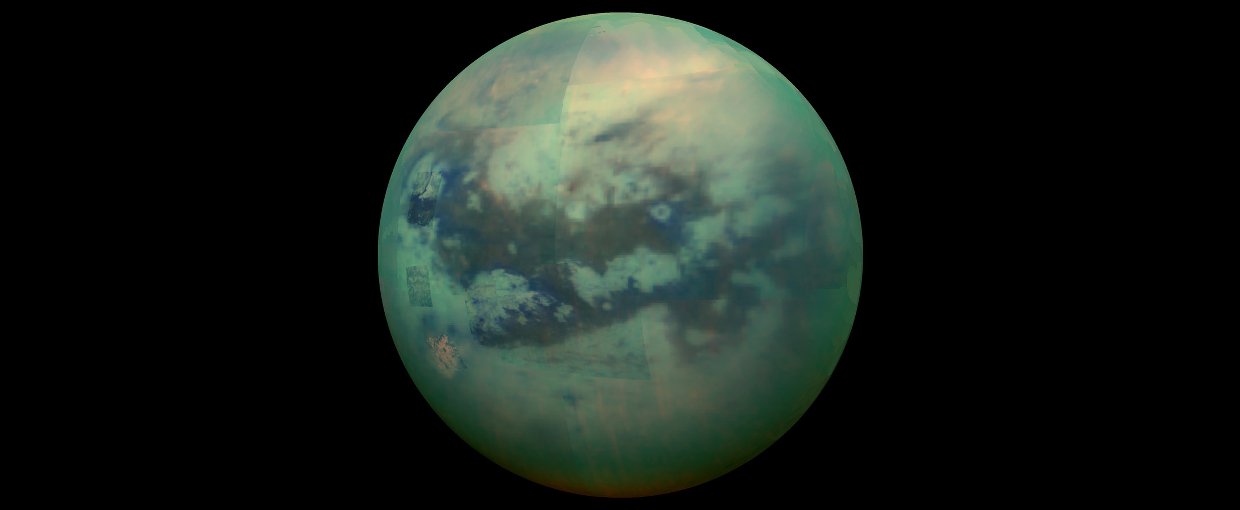
Unmanned missions to planets and moons and asteroids in our solar system have been some of NASA’s most successful efforts in recent years, with completed or on-going ventures to Mars, Saturn, Jupiter, the asteroid Bennu, our moon, Pluto, Mercury and bodies around them all. On deck are a funded mission to Europa, another to Mars and one to the unique metal asteroid 16 Psyche orbiting the sun between Mars and Jupiter.
We are now closer to adding another New Frontiers class destination to that list, and NASA announced this week that it will be to either Saturn’s moon Titan or to the comet 67P/Churyumov-Gerasimenko.
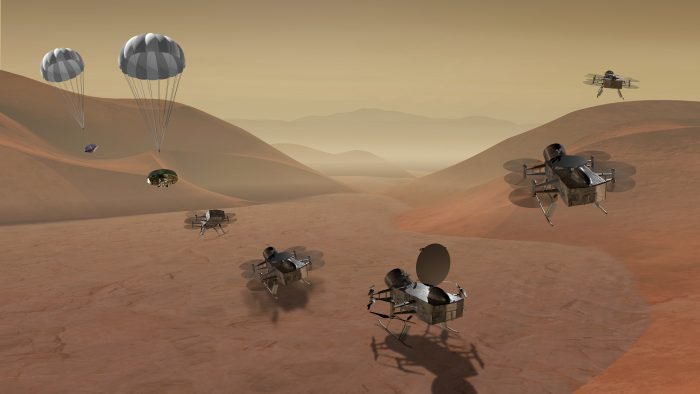
Dragonfly is a quadcopter lander that would fly to locations on Titan hundreds of miles apart. It would sample materials and determine the composition of the surface. One goal would be to analyze Titan’s organic chemistry and assess its habitability.Image credit: NASA.
After assessing 12 possible New Frontiers proposals, these two made the cut and will receive $4 million each to further advance their proposed science and technology. One of them will be selected in spring of 2019 for launch in the mid 2020s.
With the announcement, associate administrator for NASA’s Science Mission Directorate Thomas Zurbuchen described the upcoming choice as between two “tantalizing investigations that seek to answer some of the biggest questions in our solar system today.”
Those questions would be: How did water and other compounds essential for life arrive on Earth? Comets carry ancient samples of both, and so can potentially provide answers.
And with its large inventories of nitrogen, methane and other organic compounds, is Titan potentially habitable? Then there’s the added and very intriguing prospect of visiting the methane lakes of that frigid moon.

The CAESAR mission would return to the nucleus of comet explored by the European Space Agency’s Rosetta mission, and its lander Philae.Image credit: NASA.
Both destinations selected have actually been visited before.
The European Space Agency’s Rosetta mission orbited the comet 67P/Churyumov-Gerasimenko comet for two years and deployed a lander, which did touch down but sent back data for only intermittently for several days.
And the NASA’s Cassini-Huygens mission to Saturn passed by Titan regularly during its decade exploring that system, and the ESA’s Huygens probe did land on Titan and sent back information for a short time.
So both Rosetta and Cassini-Huygens began the process of understanding these distant and potentially revelatory destinations, and now NASA is looking to take it further.
The Titan “Dragonfly” mission, for instance, would feature a “quadcopter” or “rotorcraft” — a vehicle that is part helicopter and part drone. It’s designed to hop hundreds of miles around the moon to sample what has already been determined to be a surface with many organic compounds and liquid methane lakes.
Those already identified hydrocarbon seas may contain amino acids and other interesting molecules, making Titan a test bed of sorts on how life arose on Earth. With spectrometers, drills, and cameras, Dragonfly would split its mission between science in the air and on the ground.
Although frigid, Titan is otherwise now known to be a relatively benign place, and the rotorcraft could potentially survive for several years. That could give the team time to “evaluate how far prebiotic chemistry has progressed in an environment where we know we have the ingredients for life,” said lead investigator Elizabeth Turtle from the Johns Hopkins University Applied Physics Laboratory (APL) in Laurel, Maryland.
“Titan is a unique ocean world, with lakes and rivers of liquid methane flowing across its surface,” she said. But it is also very cold. Average surface temperatures are -290 degrees Fahrenheit, so any potential lifeforms would face some major challenges.
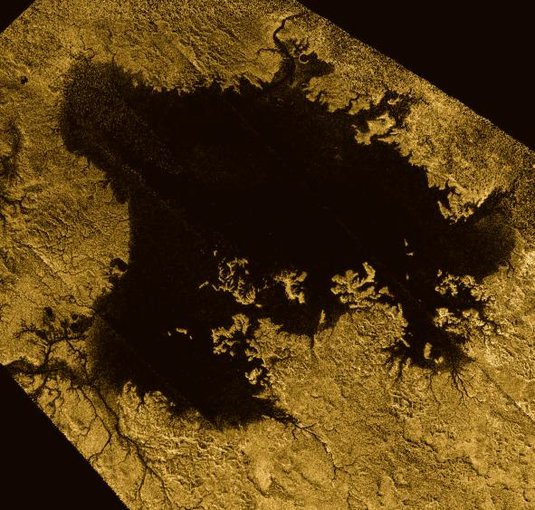
A methane lake near the northern pole of Saturn’s moon, Titan. The image was taken using radar on the Cassini spacecraft.Image credit: NASA/JPL-Caltech.
The comet mission CAESAR (Comet Astrobiology Exploration SAmple Return) will take a very different route than Rosetta did and will use different propulsion that will get the spacecraft to the comet in four years. The plan is to then perform a “touch and go” maneuver with an extended arm to pick up 100 grams of precious Rosetta material from the nucleus.
And then unlike with Rosetta, the plan is to cache the sample and bring it back to Earth for intensive study.
By returning to 67P/Churyumov-Gerasimenko, a body mapped in detail by Rosetta, the mission is “able to design our spacecraft specifically for the conditions we know,” said Steven Squyres of Cornell University, principal investigator for the mission.
During a news conference, Squyres said that “comets are among the most scientifically important objects in the solar system, but they’re also among the most poorly understood.
“They’re the most primitive building blocks of planets; they contain materials that date from the very earliest moments of solar system formation and even before. Comets were a source of water for the Earth’s oceans, and critically they were a source of organic molecules that contributed to the origin of life.”
Squyres told me after the announcement that the CAESAR instruments will allow for more precise measurements than from Rosetta, and that a successful sample return could potentially change our understanding of the Earth’s history substantially. He said the sample collection would also importantly include gases.
NASA has already succeeded with comet sample return — the Stardust mission to fly through the plume of comet Wild-2. It did gather some dust, but it didn’t land on the nucleus like Rosetta did and CAESAR would.
Sample return is clearly a high priority for NASA and other space agencies. The NASA 2020 mission to Mars is designed to collect and cache rock samples for later return, and two other sample return missions are underway. Both are to asteroids, with one launched last year by NASA and the other by the Japanese space agency JAXA in 2014.
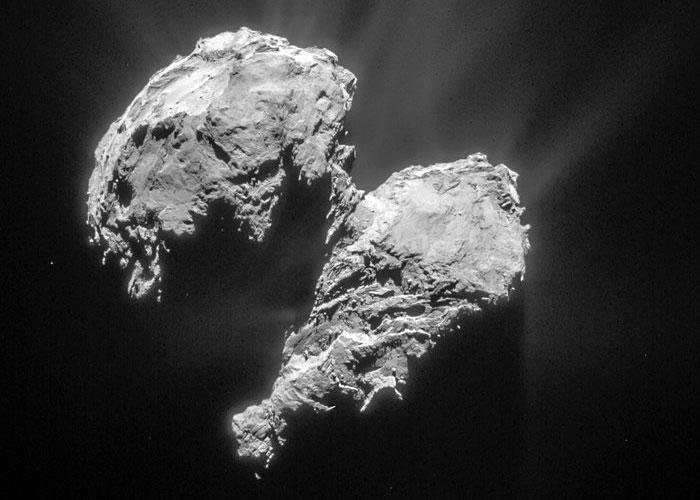
The nucleus of the 67P/Churyumov-Gerasimenko comet, where the CAESAR mission hopes to be headed in the 2020s.Image credit: ESA.
What “Dragonfly” would return is data about a moon shrouded in haze and unlike any other body in our solar system.
When the Huygen’s probe descended to the moon in early 2005, planetary scientists weren’t sure if the moon’s surface was covered in oceans methane and ethane. So Huygens was designed to float if solid ground wasn’t to be found.
As the lander sailed through the haze it took hundreds of aerial images that showed an alien but strikingly Earth-like landscape of mountains, dry floodplains and what appeared to be river deltas. Huygens did land on something solid, though liquid methane flowed nearby and the Huygens cameras could see intricate channels cutting into the surface.
When Huygens touched down, it did so with a soft thud and a short slide across the frozen surface. Later analysis of the lander’s telemetry showed that Huygens sank around 4.7 inches into the surface on first contact, bounced and slid before coming to a stop.
This knowledge made possible a Titan project with a lander that can jump from one spot to another quite far away. Those methane lakes, it is now understood, are largely found near the northern pole, and so floatation equipment is no longer necessary.
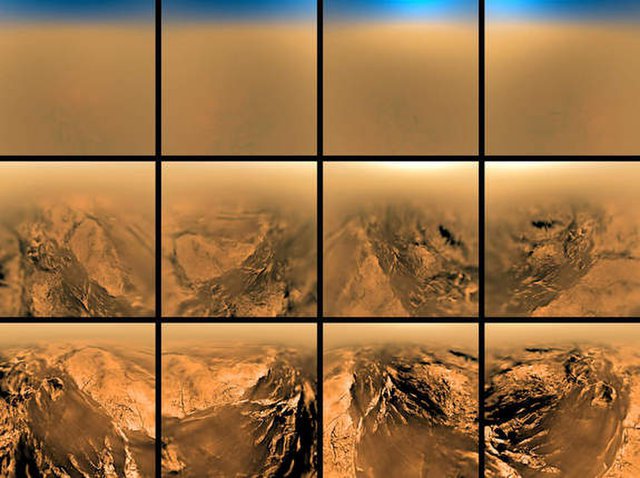
The Huygens descent to the surface of Titan, as recorded in 2005.Image credit: ESA/NASA.
Squyres, a professor of physical science at Cornell University, is also principal investigator for the long-lasting Mars exploration rovers, one of which operated successfully for 8 years and the other –Opportunity — is still exploring Mars 13 years after landing.
He told me that his long years heading the Mars rover mission had convinced him that his greatest satisfaction in science comes from identifying a plausible space project, putting together a team of scientists, engineers and managers who can plausibly pull it off, and then work nonstop for years putting together a proposal to get it selected and funded. His team now numbers about 150 people and will soon grow much larger.
It was that sense of “shared struggle,” he said, that gave him enormous satisfaction. That came, of course, with a happy ending in several competitions, but he said he also knows the disappointment of not being selected for others.
Two other missions were selected for additional, though limited, funding under the New Frontiers program. One is headed by NASA Ames Research Center astrobiologist Chris McKay and will be funded to develop “cost-effective techniques that limit spacecraft contamination and thereby enable life detection measurements on cost-capped missions.”
The larger mission his team proposed would go to the water vapor plume spurting out of Saturn’s moon Enceladus, with the goal of searching for signs of life.
The two projects selected were no doubt something of a disappointment to researchers who have longed for NASA to return to Venus. As the study of exoplanets progresses, one of the key questions facing scientists is why Earth and Venus evolved so differently. Both are within our sun’s habitable zone, but Venus experienced a runaway greenhouse effect that parched the surface and pushed surface temperatures to a led-melting 870 degrees F.
Three of the proposed New Frontiers missions were to Venus but, as in other recent competitions, none were selected by NASA. One of the Venus proposals, led by Goddard’s Lori Glaze, was selected for further technology development.

Venus hasn’t been visited by a NASA spacecraft in decades, leading to hopes that one of the New Frontiers finalists would be a mission there. But it was not to be. ESA operated the Venus Express mission orbiting the planet from 2006 to 2014 and the Japanese Space Agency has a probe (Akatsuki) here now.Image credit: NASA.
Also noticeably absent among the finalists was any pr0ject going to the moon, especially since the Trump administration has made a lunar colony a priority. Apparently a New Frontiers mission is not what the administration has in mind.
New Frontiers initiative is the largest NASA planetary exploration program open to outside competition and leadership. But NASA does set the priorities, as put forward by the planetary science and astrobiology communities.
Previous spacecraft launched under New Frontiers include New Horizons, which surveyed Pluto and is now due to visit MU69, an icy object in the farthest reaches of the solar system; Juno, now in orbit around Jupiter; and OSIRIS-REx, launched last year, which will collect samples from an asteroid and return them to Earth.
Since the New Frontiers program began at the beginning of the century, NASA has selected two missions for each decade, making them the most frequent of the major agency missions. Costs are capped at $1 billion — with $850 million for the mission and $150 million for the launch. So far, the money has been demonstrably well spent.
